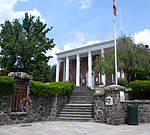Westchester Hills Cemetery
1919 establishments in New York (state)Cemeteries in Westchester County, New YorkJewish cemeteries in New York (state)

The Westchester Hills Cemetery is at 400 Saw Mill River Road in Hastings-on-Hudson, Westchester County, New York, approximately 20 miles north of New York City. It is a Jewish cemetery, and many well-known entertainers and performers are interred there. It was founded by the Stephen Wise Free Synagogue in 1919 when the synagogue acquired the northern portion of the Mount Hope Cemetery.
Excerpt from the Wikipedia article Westchester Hills Cemetery (License: CC BY-SA 3.0, Authors, Images).Westchester Hills Cemetery
Saw Mill River Road,
Geographical coordinates (GPS) Address Nearby Places Show on map
Geographical coordinates (GPS)
| Latitude | Longitude |
|---|---|
| N 40.992222222222 ° | E -73.86 ° |
Address
Saw Mill River Road
Saw Mill River Road
10502
New York, United States
Open on Google Maps







